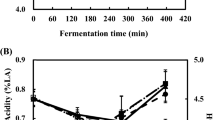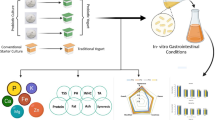Abstract
It is a practice to add microalgae into plain and probiotic fermented milks in order to promote the functionality of these products via their direct health effects as well as the enhancing impact on viability of probiotic microorganisms in product and in gastrointestinal tract. In this study, the effects of addition of two species of microalgae including Arthrospira platensis and Chlorella vulgaris (seven yogurt treatments containing three concentrations for each microalgae—0.25, 0.50, and 1.00 %—and a control without microalgae) on pH, titrable acidity, and redox potential changes as well as on the viability of probiotic bacteria during fermentation and during a 28-day refrigerated storage period (5 °C) were investigated in yogurt. Also, the amounts of lactic and acetic acids at the end of fermentation were assessed. The culture composition of yogurt was ABY type, containing Lactobacillus acidophilus LA-5, Bifidobacterium lactis BB-12, Lactobacillus delbrueckii ssp. bulgaricus, and Stresptococcus themophilus. The addition of microalgae significantly (p < 0.05) increased the viability of L. acidophilus and bifdobacteria at the end of fermentation and during the storage period. Treatments containing A. platensis had slower pH decline, faster acidity increase, longer incubation time, and greater final titrable acidity than those containing C. vulgaris and control. In treatments containing 0.5 or 1 % microalgae, the viability was almost higher than 107 cfu/mL until the end of refrigerated storage.



Similar content being viewed by others
References
Korbekandi H, Mortazavian AM, Iravani S (2011) Stability and technology of probiotic in fermented milks. In: Shah N (ed) Probiotic and prebiotic foods: technology, stability and benefits to the human health. Nova Science Publishing Ltd, USA, pp. 131–169
Mortazavian AM, Khosrokhavar R, Rastgar H, Mortazaei GR (2010) Effects of dry matter standardization order on biochemical and microbiological characteristics of Doogh (Iranian fermented milk drink). Ital J Food Sci 1:98–104
Shafiee G, Mortazavian AM, Mohammadifar MA, Koushki MR, Mohammadi AR, Mohammadi R (2010) Combined effects of dry matter content, incubation temperature and final pH of fermentation on biochemical and microbiological characteristics of probiotic fermented milk. Afr J Microbiol Res 4:1265–1274
Shah NP (2001) Functional foods from probiotics and prebiotics. Food Tech 55:46–53
Sohrabvandi S, Razavi SH, Mousavi SM, Motazavian AM (2010) Viability of probiotic bacteria in low- alcohol- and non-alcoholic beer during refrigerated storage. Philipp Agric Scientist 93:24–28
Tamime AY, Saarela M, Korslund Sondergaard A, Mistry VV, Shah NP (2005) In: Tamime AY (ed) Probiotic dairy products. Blackwell Publishing Ltd, UK
Heydari S, Mortazavian AM, Ehsani MR, Mohammadifar MA, Ezzatpanah H, Sohrabvandi S (2011) Biochemical, microbiological and sensory characteristics of probiotic yogurt containing various prebiotic or fiber compounds. Ital J Food Sci 23:153–163
Mortazavian AM, Ehsani MR, Mousavi SM, Rezaei K, Sohrabvandi S, Reinheimer JA (2007) Effect of refrigerated storage temperature on the viability of probiotic micro-organisms in yogurt. Int J Dairy Technol 60:123–127
Sadaghdar Y, Mortazavian AM, Ehsani MR (2012) Survival and activity of five probiotic lactobacilli strains in two types of flavored fermented milk. Food Sci Biotechnol 1:151–157
Ahmadi E, Mortazavian AM, Fazeli MR, Ezzatpanah H, Mohammadi R (2012) The effects of inoculants variables on the physicochemical and organoleptic properties of Doogh. Int J Diary Technol 2:274–281
Mortazavian AM, Ehsani MR, Azizi A, Razavi SH, Mousavi SM, Sohrabvandi S (2008) Viability of calcium alginate-microencapsulated probiotic bacteria in Iranian yogurt drink (Doogh) during the refrigerated storage period and under the simulated gastrointestinal conditions. Aust J Dairy Tech 63:24–29
Anon: Iran national standard for probiotic yogurt; No. 11325. Available on www.isiri.org [In Persian] 2008a
Mortazavian AM, Ehsani MR, Mousavi SM, Reinheimer JA, Emamdjame Z, Sohrabvandi S, Rezaei K (2006) Preliminary investigation of the combined effect of heat treatment and incubation temperature on the viability of the probiotic micro-organisms in freshly made yogurt. Int J Dairy Technol 59:8–11
Mortazavian AM, Sohrabvandi S, Mousavi SM, Reinheimer JA (2006) Combined effects of temperature-related variables on the variables on the viability of probiotics in yogurt. Aus J Dairy Tech 61:248–252
Mortazavian AM, Sohrabvandi S, Reinheimer JA (2007) MRS-bile agar: Its suitability for the enumeration of mixed Probiotic cultures in cultured dairy products. Milchwissenschaft 62:270–272
Mortazavian AM, Ghorbanipour S, Mohammadifar MA, Mohamadi M (2011) Biochemical properties and viable probiotic population of yogurt at different bacterial inoculation rates and incubation temperatures. Philipp Agric Scientist 94:111–116
Gyenis B, Szigeti J, Molnar N, Varga L (2005) Use of dried microalgal biomasses to stimulate acid production and growth of Lactobacillus plantarum and Enterococcus faecium in milk. Acta Agraria Kaposváriensis 9:53–59
Molnar N, Gyenis B, Varga L (2005) Influence of powdered A. platensis platensis biomass on acid production of lactococci in milk. Milchwissenschaft 4:380–382
Varga L, Szigeti J, Kovacs R, Foldes T, Buti S (2002) Influence of a A. platensis platensis biomass on the microflora of fermented ABT milks during storage (R1). J Dairy Sci 85:1031–1038
Caire GZD, Parada JL, Zaccaro MC, Cano MM (2000) Effect of A. platensis platensis biomass on the growth of lactic acid bacteria in milk. World J Microbiol Biotechnol 16:563–565
Shimamatsu H (2004) Mass production of A. platensis, an edible microalga. Hydrobiologia 512:39–44
Spolaore P, Joannis-Cassan Duran E, Isambert A (2006) Commercial applications of microalgae. J Biosci Bioengineer 2:87–96
Mendiola JA, Jaime L, Santoyo S, Reglero G, Cifuentes A, Ibanez E, Senoráns FJ (2007) Screening of functional compounds in supercritical fluid extracts from A. platensis platensis. Food Chem 102:1357–1367
Parada JL, Ceire GZD, Mule MCZ (1998) Cano MMS: Lactic acid bacteria growth promoters from A. platensis platensis. Int J Food Microbiol 45:225–228
Varga L, Szigeti J (1998) Microbial changes in natural and algal yoghurts during storage. Acta Alimen 2:127–135
Mendes RL, Nobre BP, Cardoso MT, Pereira AP, Palavra AF (2003) Supercritical carbon dioxide extraction of compounds with pharmaceutical importance from microalgae. Inorg Chim Acta 356:328–334
Zielke H, Kneifel H, Webb LE, Soeder CJ (1978) Stimulation of lactobacilli by an aqueous extract of the green alga Scenedesmus acutus 276–3a. Eur J Appl Microbio Biotechnol 6:79–86
Varga L, Szigeti J, Ördög V (1999) Effect of a A. platensis platensis biomass and that of its active components on single strains of dairy starter cultures. Milchwissenschaft 54:187–190
Sohrabvandi S, Mortazavian AM, Dolatkhah-nejad MR, Bahadori Monfared A (2012) Suitability of MRS-bile agar for the selective enumeration of mixed probiotic bacteria in presence of mesophilic lactic acid cultures and yogurt bacteria. Iran J Biotechnol 10:16–21
Anon (2008b) Iran national standard for plain yogurt; No. 4046. Available on www.isiri.org (in Persian)
Molnar N (2009) Development of functional dairy food enriched by A. platensis. Tejgazdaság 2:15–22
Gibson GR, Roberfroid MB (1995) Dietary modulation of the human colonic microbiota: introducing the concept of prebiotics. J Nutr 125:1041
Kurita H, Tajima O, Fukimbara T (1979) Isolation and identification of nucleosides in Chlorella extract. J Agr Chem Soc Jap 4:131–133
Shirota M, Nagamatsu N, Takechi Y (1964) Method for cultivating lactobacilli. US Patent 3,123, 128
Stengel E (1970) Anlagentypen und Verfahren der technischen Algenmassenproduktion. Ber Dtsch Bot Ges 83:589–606
Webb LE (1982) Detection by Warburg manometry of compounds stimulatory to lactic acid bacteria. J Dairy Res 49:479–486
Acknowledgments
This study, from a M.Sc. thesis of National Nutrition and Food Technology Research Institute (Shahid Beheshti University of Medical Sciences, Tehran, Iran), was financially and operationally supported by this institute.
Author information
Authors and Affiliations
Corresponding author
Rights and permissions
About this article
Cite this article
Beheshtipour, H., Mortazavian, A.M., Haratian, P. et al. Effects of Chlorella vulgaris and Arthrospira platensis addition on viability of probiotic bacteria in yogurt and its biochemical properties. Eur Food Res Technol 235, 719–728 (2012). https://doi.org/10.1007/s00217-012-1798-4
Received:
Revised:
Accepted:
Published:
Issue Date:
DOI: https://doi.org/10.1007/s00217-012-1798-4




